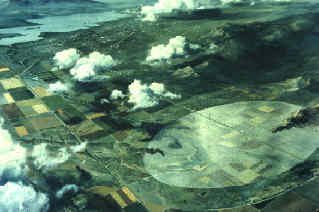

Hydroponics is a relatively new technology, evolving rapidly since its inception 70 years ago. From its origins in academic research, to its utilization in industry and government, hydroponics has found many new applications. It is a versatile technology, appropriate for both developing countries and high-tech space stations. Hydroponic technology can efficiently generate food crops from barren desert sand and desalinated ocean water, in mountainous regions too steep to farm, on city rooftops and concrete schoolyards and in arctic communities. In highly populated tourist areas where skyrocketing land prices have driven out traditional agriculture, hydroponics can provide locally grown high-value specialty crops such as fresh salad greens, herbs and cut flowers.
Like manufacturing, agriculture tends to move toward higher-technology, more capital-intensive solutions to problems. Hydroponics is highly productive and suitable for automation. However, the future growth of controlled environment agriculture and hydroponics depends greatly on the development of systems of production that are cost-competitive with those of open field agriculture. Improvements in associated technologies such as artificial lighting and agricultural plastics, and new cultivars with better pest and disease resistance will increase crop yields and reduce unit costs of production. Cogeneration projects, where hydroponic greenhouses utilize waste heat from industry and power plants, are already a reality and could expand in the next few years. Geothermal heat could support large expanses of greenhouses in appropriate locations.
 It has been proposed that glasshouses
located in deserts of the world could one day serve a dual
purpose, where antenna could be embedded into the glass to
receive energy radiation from an array of energy collectors in
space, while at the same time facilitate hydroponic tomato
production.
It has been proposed that glasshouses
located in deserts of the world could one day serve a dual
purpose, where antenna could be embedded into the glass to
receive energy radiation from an array of energy collectors in
space, while at the same time facilitate hydroponic tomato
production.
The economic prospects for controlled environmental agriculture and hydroponics may improve if governmental bodies determined that there are politically desirable effects of hydroponics that merit subsidy for the public good. Such beneficial effects may include the conservation of water in regions of scarcity or food production in hostile environments; governmental support for these reasons has occurred in the Middle East. Another desirable societal effect could be the provision of income-producing employment for chronically disadvantaged segments of the population entrapped in economically depressed regions; such employment produces tax revenues as well as personal incomes, reducing the impact on welfare rolls and improving the quality of life.
Hydroponics is a technical reality. Such production systems are producing horticultural crops where field-grown fresh vegetables and ornamentals are unavailable for much of the year. The development and use of controlled environment agriculture and hydroponics have enhanced the economic well being of many communities throughout the world.